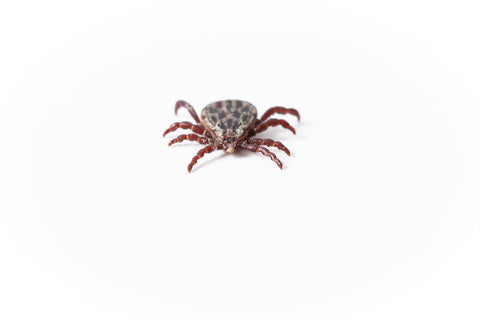Prevent Lyme In Dogs Month

For pet owners who have an indoor-outdoor dog, we recommend that you pay attention and learn about Lyme Disease Prevention Month in Dogs, this April.
The reason that April is chosen to explore this topic is because dogs are at an increased risk of being bit by a tick in the spring and summer months as wildlife are out scouting for food.
Tick Concerns
Since winter is over, the snow has melted and temperatures have risen above freezing (32 degrees Fahrenheit). Because of this, deer and other wildlife carrying ticks are coming out of the woodwork to scout for food in home gardens. This action from deer (the number one carriers of ticks in the United States) leads to tick droppings and the potential for a tick bite.
About Eastern Black-Legged Ticks The Eastern Black-legged tick, also known as the 'deer tick' is the most common sighted tick species in grassy and woody areas. Not only do they tend to hide underneath leaves/ fire logs, but they can be found on hiking trails and in home gardens where there are opportunities to feed on warm-blooded mammals. Although they are known as the 'deer tick,' they will also feed on other types of wildlife, pets and humans.
The Eastern Black-legged tick, also known as the 'deer tick' is the most common sighted tick species in grassy and woody areas. Not only do they tend to hide underneath leaves/ fire logs, but they can be found on hiking trails and in home gardens where there are opportunities to feed on warm-blooded mammals. Although they are known as the 'deer tick,' they will also feed on other types of wildlife, pets and humans.
The Eastern Black-legged tick is the most common tick species in North America carrying the notorious tick-borne disease, Lyme Disease. We focus so much on human diagnosis, that we do not consider the fact that dogs and cats can be diagnosed with Lyme, too.
While not all ticks carry Lyme, they can carry other harmful tick diseases including Rocky Mountain Spotted Fever (American Dog Ticks) and Canine Anaplasmosis.
It's important to always groom pets after outdoor playtime and search for ticks that may be hiding in the fur. Ticks generally hide on dogs in the following areas:
- Between toes
- In the groin area
- Underneath dog collars/clothes
- Elbows
- Under the tail
- In and around the ears
Know how to remove a dog tick, if spotted.
Lyme Disease in Dogs
Lyme Disease is generally spread by ticks within 24-48 hours of attaching to a human or dog. If your dog is experiencing the following symptoms, then the dog may have a tick bite.
- Vomiting
- Regurgitation
- Unsteadiness
- High blood pressure
- Fast heart rate and rhythm (tachyarrhythmias)
- Weakness, especially in the hind limbs
- Partial loss of muscle movements (paresis)
- Complete loss of muscle movement (paralysis), commonly seen in advanced disease state
- Poor reflexes to complete loss of reflex
- Low muscle tone (hypotonia)
- Difficulty in eating
- Disorder of voice (dysphonia)
- Asphyxia due to respiratory muscle paralysis in severely affected animals
- Excessive drooling (sialosis)
- Megaesophagus (enlarged esophagus)
- Excessive dilatation of pupil in the eye (mydriasis)
Clinical illness in dogs lasts from 2-5 months; and can be treated with antibiotics like Doxycycline or Amoxicillin, if caught in the early stages.
Is Lyme Disease Fatal In Dogs?
Some dogs that develop kidney disease from #Lyme become severely ill or die. See a vet as soon as you successfully remove the dog tick from your pet's skin.
Conclusion
"Massachusetts, New York, and Pennsylvania have reported the highest number of borreliosis-positive dogs in the country, according to Merial, which says infected dogs have been reported in all 50 states. One reason may be that dogs with borreliosis are traveling with their owners and being tested in areas of the country that typically do not have ticks that transmit the bacteria, the company explained." (AVMA)
For Prevent Lyme In Dogs Month, EasyPetFence encourages homeowners to install a dog fence around properties to keep out wildlife that may be carrying ticks. The logic is simple: Keep out deer, reduce the risk of tick diseases.
